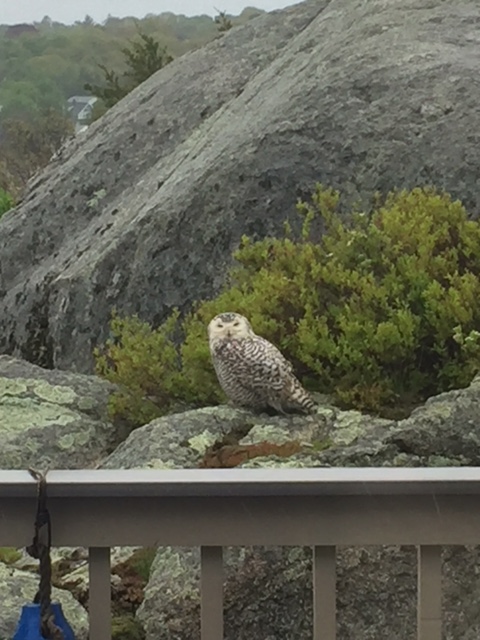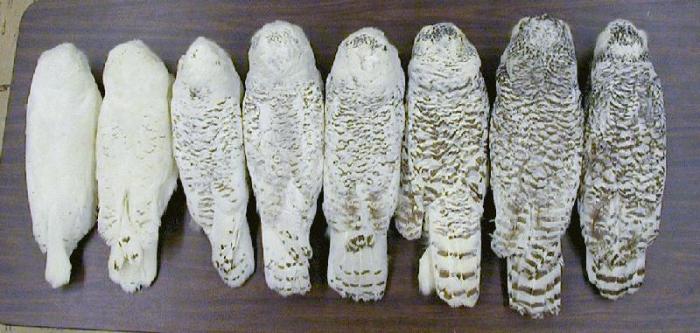 Hedwig was observed Saturday morning, when repeated harassment by a flock of crows sent her hiding. She reappeared Saturday afternoon, and was again seen Sunday morning in the drizzle, not too far from where she was perched Saturday evening. Later Sunday afternoon she slept and rested in the pouring rain.
Hedwig was observed Saturday morning, when repeated harassment by a flock of crows sent her hiding. She reappeared Saturday afternoon, and was again seen Sunday morning in the drizzle, not too far from where she was perched Saturday evening. Later Sunday afternoon she slept and rested in the pouring rain.
Hedwig sleeping in the rain (thank you to Arly Pett for letting me know she was out in the rain!)
That she stays in a highly localized winter territory seems in keeping with known Snowy Owl behavior traits. I read that during the summer season in the Arctic, male Snowies hunt over hundreds of miles, whereas female Snowies typically hunt within a much smaller range. She has been observed eating sea ducks and rabbits and there are plenty of rat holes along the backshore rocks.
Both rats and lemmings (the Snowies super food in the Arctic) belong to the order Rodentia. From wiki, “A lemming is a small rodent usually found in or near the Arctic in tundra biomes. Lemmings are subnivean animals. They make up the subfamily Arcicolinae together with voles and muskrats which forms part of the superfamily Muroidea which also includes rats, mice, hamsters, and gerbils.”
 Lemming (Lemmini)
Lemming (Lemmini)
Often Hedwig has been seen flying straight out over the water towards Twin Lights. I wondered, if she is hunting there, does Thacher Island have a rat population. Thacher Island Association president Paul St. Germain answers that question for our readers,
“Hi Kim, there are lots of rats on Thacher mostly in the shore line rocks. We don’t see them often but know they are there. I discovered a bunch in the cellar of the keeper house making their nest in an old tarp. I would love to see Hedwig out there but we don’t go out in the winter. Have never seen snowy owls in the summer.”
Great info and thanks to Paul for sharing that! A Snowy Owl has been seen on the rocks in Rockport, across the strait, opposite Twin Lights, and wonder if it is our Hedwig.
Rat and Lemming photos courtesy wiki commons media
This brings up the topic, what to do if you have a rat problem. The absolute worst way to control rats is with rat poison, namely for the sake of beautiful predatory birds such as Snowy Owls, falcons, hawks, and eagles. Birds that ingest rats that have been poisoned with rat poison will generally become gravely ill and die. Secondly, it is a cruel, slow death for the rat. They will usually go back to their nest to die. If that nest is located behind a wall in your home, you will smell that unmistakeable horrendous smell for many months. Thirdly, rat poison is only 60 percent effective. I wonder if the rats that survive rat poison will go on to breed super rats.
The best way to avoid having to kill a rat is to make sure they cannot gain access to your home or business by regularly inspecting soffits and woodwork for holes. Old-fashioned snap traps and live trapping continue to be the most effective way to rid your home or business of rats.
Saturday I stopped to say hello to a group of birders flocked together along the backshore who had traveled all the way from western Mass. They were observing Grebes, Buffleheads, and a Common Murre. And a Puffin had been spotted! I asked if they were planning to go to any of our local restaurants for lunch, but they had packed lunches. One Mom shared that an expert from Audubon told the group that there were at least a “dozen Snowy Owls” on Bass Rocks. Bananas! I have to say that it makes me hoppin’ mad when folks spread misinformation about our local wildlife. I gently told her that no, there were not a dozen owls, but that if she and her group waited until late afternoon, they might catch sight of Hedwig.

 Twin Lights from a Snowy Owl POV
Twin Lights from a Snowy Owl POV
Spread The GMG Love By Sharing With These Buttons:



































































































































